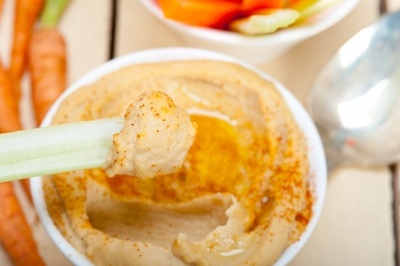
Chickpeas (Cicer arietinum L.) or garbanzo beans are now the second most important pulse or legume crop in the world. They have been used for over a thousand years mainly because of its high protein content which has been accepted in the human diet for millenia.
It offers the culinologist and product developer a wide range of textures especially because of its high starch content and various polysaccharides. These stand up well during high heat treatments which lends itself well to cooking. Who of course is not aware of the great product made from mashed chickpeas, hummus ?
Other Names
The bean is also known as Ceci bean, Bengal gram or Egyptian pea. In India they are known as chana or chole in Hindi. I’m sure many of us have eaten a chana dahl in our time. We know of at least 50 different varieties. The most common variants are pale-brown, black, green, and red chickpeas.
Nutrition Of Chickpeas
The chickpea is a good source of protein of between 180 to 290 g/kg and contains essential amino acids such as lysine, leucine, isoleucine and tryptophan. It is unfortunately not such a good source of the sulphur-containing amino acids like cysteine and methionine.
Chickpeas are a useful source of vitamins and minerals. They are also a great source of fibre.
One of the leading fermented foods is tempeh and its flour (Reyes-Moreno et al., 2004; Angulo-Bejarano et al., 2008) which is an excellent way of preserving the properties of this sought after food.
A 1-ounce (28-gram) serving provides the following key nutrients:
- Calories: 46
- Carbs: 8 grams
- Fibre/fiber: 2 grams
- Protein: 3 grams
- Iron: 4% of the RDI
- Folate: 12% of the RDI
- Phosphorus: 5% of the RDI
- Copper: 5% of the RDI
- Manganese: 14% of the RDI
Chickpeas also contain an indigestible sugar called raffinose. The carbohydrates containing raffinose are known as the raffinose family oligosacharides (RFO). These make up between 50% and 75% of the total sugars (Wallace et al., 2016). Being indigestible means they are associated with excessive gas accumulation in the intestine. It’s been one of the issues that has put consumers off chickpeas as particular protein source.
Chickpea protein hydrolysate (CPH) has good antioxidant properties and is a valuable if not widely known ingredient alternative to whey and other protein products such as pea (Li et al., 2008). Chickpea protein isolate (CPPI) is also a potential ingredient with product development potential in the arena of replacing dairy proteins in products such as creamers and as foaming agents for whipped desserts for example.
Weight Management
Consuming chickpeas can help with a weight loss diet. They have a relatively low calorie density which means they possess few calories compared to the amount of nutrients. Eating low-calorie foods helps with weight loss and is easier to sustain compared to those who eat higher calorie foods.
Diabetes And Blood Sugar Management
Chickpeas may help with regulating blood sugar levels which is important in diabetes control.
The legume has a relatively low glycaemic index (GI). This is an important marker which shows how rapidly blood sugar levels rise when eating particular types of foods. Diets that use lots of low GI foods tend to be better at managing and controlling blood sugar levels (Wallace et al., 2016).
Blood Pressure Management And Cardiovascular Protection
Consuming chickpeas contributes to lowering blood pressure or hypertension. It is thought that the levels of magnesium and potassium in the legume are such that a proper electrolyte balance can be maintained.
Managing Metabolic Syndrome
We know that the gut, especially the flora and fauna which grows in it is able to modulate energy levels which is usually termed energy homeostasis and also help in the management of metabolic disorders. Bacteria in the gut to look out for are Bifidobacteria and Lactobacilli. These are often ingested as prebiotics. To promote their good health and keep them functioning in the body, we often consume probiotics. These often take the form of dietary fibre and various carbohydrates.
One of the key compounds found in chickpeas is a special type of carbohydrate, an oligosaccharide that can regulate our intestinal microbiota in a positive manner. Studies in mice show that α-galactooligosaccharides (α-GOS) from chickpea will lead to an improvement in bacteria such as Bifidobacterium and Lactobacillus (Dai et al., 2017).
Raising Energy And Immunity Levels
The chickpea is a good source of manganese as well some other nutrients such as thiamine, phosphorous and magnesium. Manganese is important because it is an essential cofactor in metabolic systems or energy production and improving the overall effectiveness of the immune system.
Hormone Regulation For Women
There are a particular group of compounds called phytoestrogens which are special phytonutrients. These compounds can help reduce the risk of breast cancer for example and protect against osteoporosis by maintaining the levels of an important sex hormone called oestrogen in the blood. The legume has also been linked to relieving mood changes in women who are menstruating and especially with post-menopausal symptoms.
Growing And Cultivation Statistics
It is grown as a staple food crop in at least 37 countries in southern Europe, North and East Africa, South and West Asia especially India and Indonesia, North and South America, and Australia. Acreage devoted to this crop now covers 15% (10.2 million hectares [ha]) of the area dedicated to pulse cultivation and accounts for 14% (7.9 million tons) of the pulse production worldwide, making it second only to dry beans (FAOSTAT, http://faostat.fao.org/default.aspx). In Israel, chickpea is the main pulse crop occupying about 10,000 ha across various regions of the land.
Chickpea seeds vary in size, shape and colour (Singh et al., 1991). Based on this variation, chickpea is classified into 2 types of seeds: “Kabuli” and “Desi” (Nizakat et al., 2007). The kabuli-type seed has a thin seed coat ranging in colour from white to cream and a 100-seed weight of 28 to 70g. Desi-type chickpea seed has a thicker skin, irregularly shaped seed coat ranging in colour from light tan to black, and 100-seed weight of up to 28g.
Safety Considerations For Chickpeas
Poor storage of chickpeas can produce contamination by Fusarium and Aspergillus spp. Aflatoxins along with other mycotoxins have been extracted and isolated from poorly stored chickpeas.
Chickpea Processing
Processing actually improves the nutritional status of the chickpea because it improves the in vitro digestibility of the carbohydrates which are mainly starch and the proteins. The improvement increases from 40% to 98%. Some of the processing also reduces the content of non-nutrition or even anti-nutrition factors like phytates for example.
The traditional processing methods are:-
- non-heat processing such as imbibition, germination and sprouting, dehulling and fermentation.
- heat processing including cooking at atmospheric pressure, autoclaving and roasting
The antinutritional factors are heat labile and these include alpha-galactosides, protease inhibitors and lectins which is why cooking is a the preferred option for chickpeas. Unfortunately there are some factors like tannins, saponins and phytic acids that are heat stable and are best reduced by dehulling, soaking, germination with or without fermentation
-Imbibition
A commonly employed technique practiced before cooking the whole legumes. It helps reduce cooking times. Soaking also helps remove some antinutritional factors that are leached into the soaking medium. These include the oligosaccharides, tannins and protease inhibitors. The degree of leaching depends on the soaking medium which can be just water, salt solutions or sodium bicarbonate solutions. Soaking the peas overnight can reduce the tannin content of chickpeas by half.
-Dehulling
This method is ideal for producing dhals using the desi type of chickpea. The pea is then further cooked or milled to a flour. Dehulling involves removal of the seed coat that contains many of the antinutritional factors such as tannins (ca. 90%). The dhal produced has a very good nutritional profile with high levels of carbohydrates, proteins and vitamins.
-Parching
In India, dry whole seeds are frequently used for parching purposes. The process requires larger seeds so cultivars are grown expressly for this. The seeds are soaked in water for between 4 and 6 hours for imbibition and then sun-dried for a day. Once the drying process is completed, the seeds are mixed with hot sand over a pot on the fire for a few minutes. The testa of the seeds cracks and the cotyledons soften. The seeds are then coloured with turmeric and seasoned with salt before being placed over the fire. About 5 to 10% of Indian chickpea production follows this approach as parched seeds are highly popular.
Products
Please note this page contains links to our affiliate marketing partner. Please note we are an Amazon Associate. Please read our affiliate disclosure.
References
Angulo-Bejarano, P. I., Verdugo-Montoya, N. M., Cuevas-Rodríguez, E. O., Milán-Carrillo, J., Mora-Escobedo, R., Lopez-Valenzuela, J. A., … & Reyes-Moreno, C. (2008). Tempeh flour from chickpea (Cicer arietinum L.) nutritional and physicochemical properties. Food Chemistry, 106(1), pp. 106-112 (Article)
Dai, Z., Lyu, W., Xie, M., Yuan, Q., Ye, H., Hu, B., … & Zeng, X. (2017). Effects of α-galactooligosaccharides from chickpeas on high-fat-diet-induced metabolic syndrome in mice. Journal of Agricultural and Food Chemistry, 65(15), pp. 3160-3166 (Article)
Li, Y., Jiang, B., Zhang, T., Mu, W., & Liu, J. (2008). Antioxidant and free radical-scavenging activities of chickpea protein hydrolysate (CPH). Food Chemistry, 106(2),pp. 444-450 (Article)
Nizakat, B., Amal, B.K., Gul, S.S.K., Zahid, M., Ihsanullah, I. (2007) Quality and consumers acceptability studies and their inter-relationship of newly evolved desi type chickpea genotypes (Cicer arietinum L.). Quality evolution of new chickpea genotypes. Int. J. Food Sci. Technol. 42 pp. 528–34.
Reyes‐Moreno, C., Cuevas‐Rodríguez, E. O., Milán‐Carrillo, J., Cárdenas‐Valenzuela, O. G., & Barrón‐Hoyos, J. (2004). Solid state fermentation process for producing chickpea (Cicer arietinum L) tempeh flour. Physicochemical and nutritional characteristics of the product. Journal of the Science of Food and Agriculture, 84(3), pp. 271-278 DOI: 10.1002/jsfa.1637
Singh, U., Subrahmanyam, N., Kumar, J. (1991) Cooking quality and nutritional attributes of some newly developed cultivars of chickpea (Cicer arietinum). J. Sci. Food Agric. 55 pp. 37–46
Wallace, T. C., Murray, R., & Zelman, K. M. (2016). The nutritional value and health benefits of chickpeas and hummus. Nutrients, 8(12), 766. (Article)


Leave a Reply